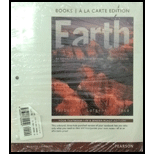
a)
The type of continental margin found on the west and east coast of South America.
a)
Answer to Problem 1GST
The west coast of South America is an active continental margin whereas the east coast of South America is a passive continental margin.
Explanation of Solution
Convergent plate boundaries are the places at which the plates move towards each other. These are also known as consuming boundaries or destructive boundaries. Among the two boundaries, one is oceanic boundary, when the plates approach each other; one of the plates sinks under the other due to the density difference. This process is known as subduction and hence, these boundaries are also known as subduction zones.
A passive continental margin is not an active plate boundary; it is the edge along a continent, or it is sediment accumulated thick zone between continent and oceanic lithosphere. The east coast of the United States is a better example of a passive continental margin with thick sedimentation of shallow-water sandstone, limestone and shales.
b)
Whether the Galapagos Rise or Rio Grande Rise is more likely to end up accreted with South America.
b)
Answer to Problem 1GST
The Galapagos Rise is attached to the oceanic plate and it is subducted under the South American plate, so Galapagos rise is more likely accreted with South America.
Explanation of Solution
Galapagos Rise is located in the west coast side of South America and it is an active plate boundary. The Nazca plate subducts under the South American plate generating continental like crust on the overriding plate.
c)
The way in which a geologist understand that this accreted landmass is distinct from the continental crust to which it accreted in the distant future.
c)
Answer to Problem 1GST
In the distant future, a geologist could understand as an accreted landmass or terrane by analyzing the composition of rocks, because the composition of the accreted landmass which is mostly basalt definitely differs from the rock in the continental crust.
Explanation of Solution
Terrane is the term used by geologists to describe a specific crustal fragment and an identifiable series of rock formation formed by the tectonic activities. A terrane is the joining of small crustal fragments that have been transported and joined by plate tectonic process along the continental margins.
Want to see more full solutions like this?
Chapter 14 Solutions
Earth: An Introduction To Physical Geology, Books A La Carte Plus Masteringgeology With Etext -- Access Card Package (11th Edition)
 Applications and Investigations in Earth Science ...Earth ScienceISBN:9780134746241Author:Edward J. Tarbuck, Frederick K. Lutgens, Dennis G. TasaPublisher:PEARSON
Applications and Investigations in Earth Science ...Earth ScienceISBN:9780134746241Author:Edward J. Tarbuck, Frederick K. Lutgens, Dennis G. TasaPublisher:PEARSON Exercises for Weather & Climate (9th Edition)Earth ScienceISBN:9780134041360Author:Greg CarbonePublisher:PEARSON
Exercises for Weather & Climate (9th Edition)Earth ScienceISBN:9780134041360Author:Greg CarbonePublisher:PEARSON Environmental ScienceEarth ScienceISBN:9781260153125Author:William P Cunningham Prof., Mary Ann Cunningham ProfessorPublisher:McGraw-Hill Education
Environmental ScienceEarth ScienceISBN:9781260153125Author:William P Cunningham Prof., Mary Ann Cunningham ProfessorPublisher:McGraw-Hill Education Earth Science (15th Edition)Earth ScienceISBN:9780134543536Author:Edward J. Tarbuck, Frederick K. Lutgens, Dennis G. TasaPublisher:PEARSON
Earth Science (15th Edition)Earth ScienceISBN:9780134543536Author:Edward J. Tarbuck, Frederick K. Lutgens, Dennis G. TasaPublisher:PEARSON Environmental Science (MindTap Course List)Earth ScienceISBN:9781337569613Author:G. Tyler Miller, Scott SpoolmanPublisher:Cengage Learning
Environmental Science (MindTap Course List)Earth ScienceISBN:9781337569613Author:G. Tyler Miller, Scott SpoolmanPublisher:Cengage Learning Physical GeologyEarth ScienceISBN:9781259916823Author:Plummer, Charles C., CARLSON, Diane H., Hammersley, LisaPublisher:Mcgraw-hill Education,
Physical GeologyEarth ScienceISBN:9781259916823Author:Plummer, Charles C., CARLSON, Diane H., Hammersley, LisaPublisher:Mcgraw-hill Education,





